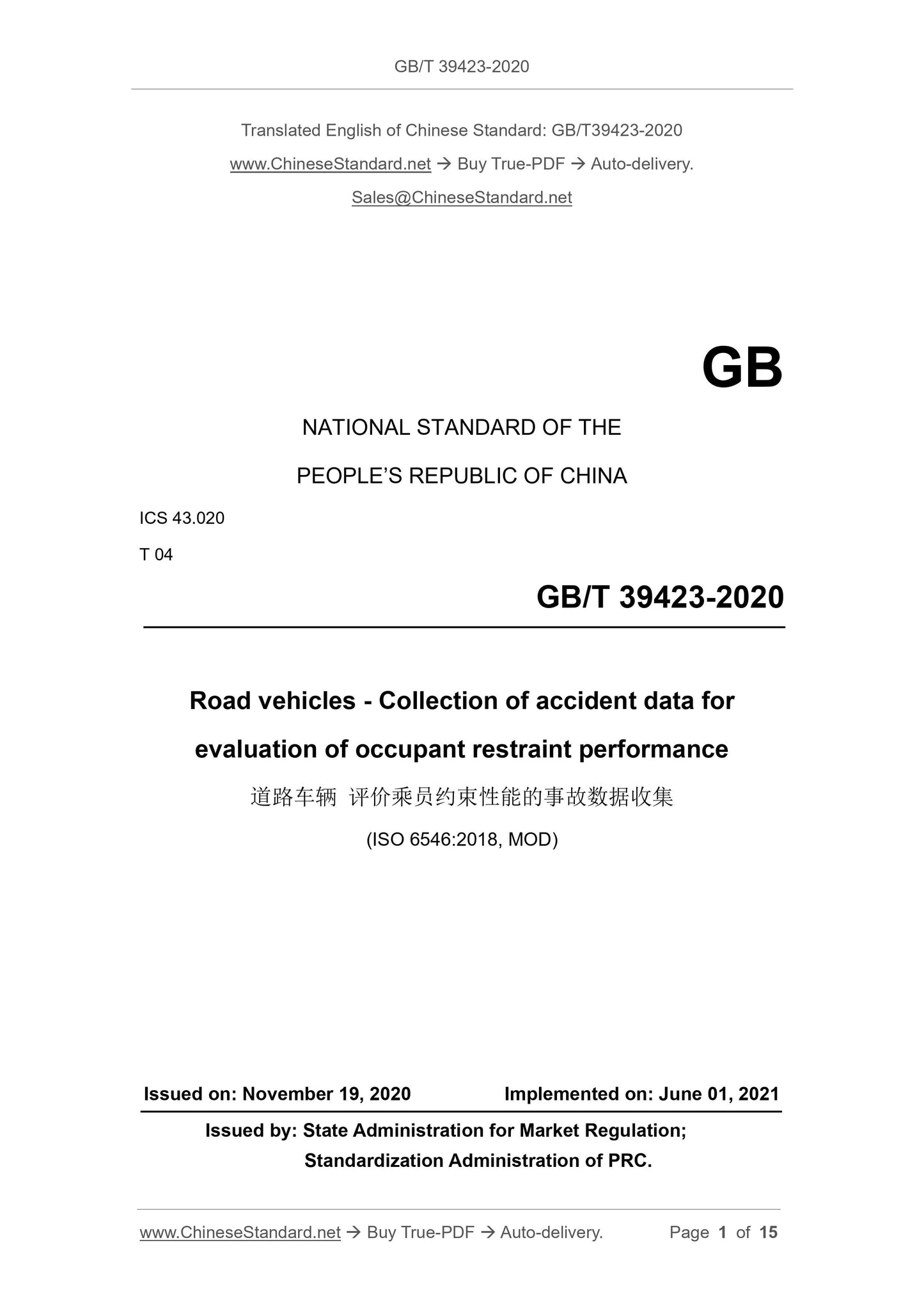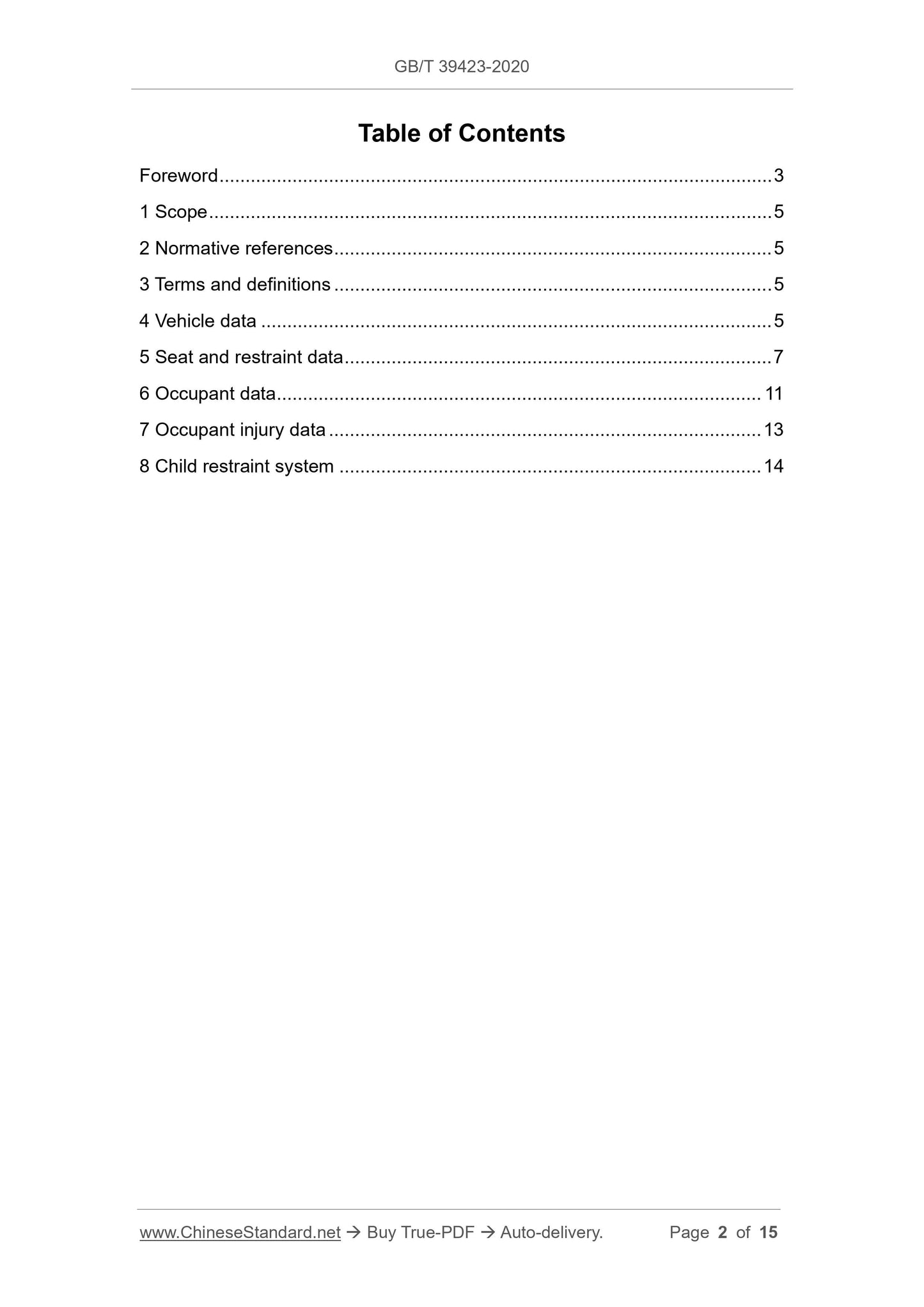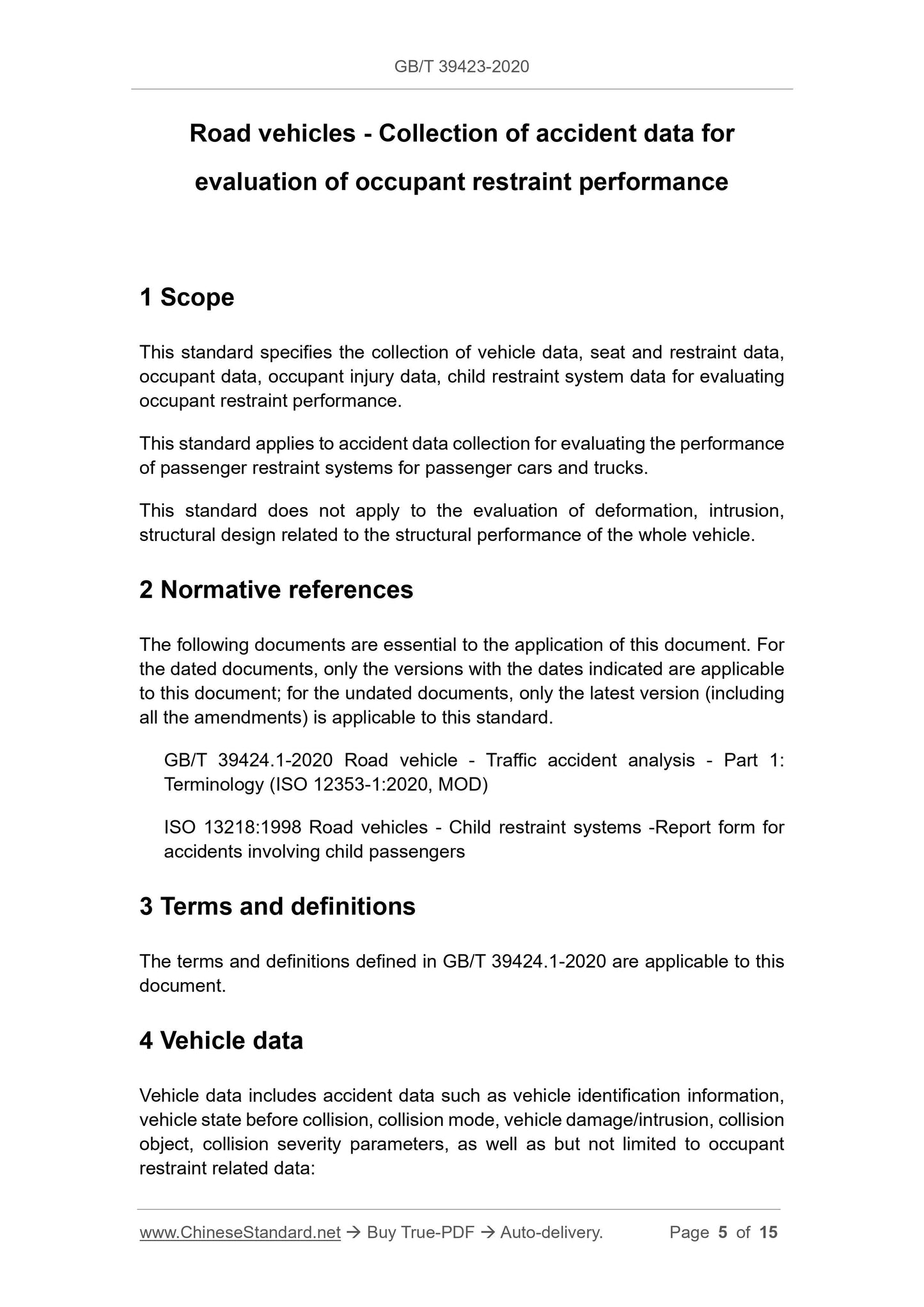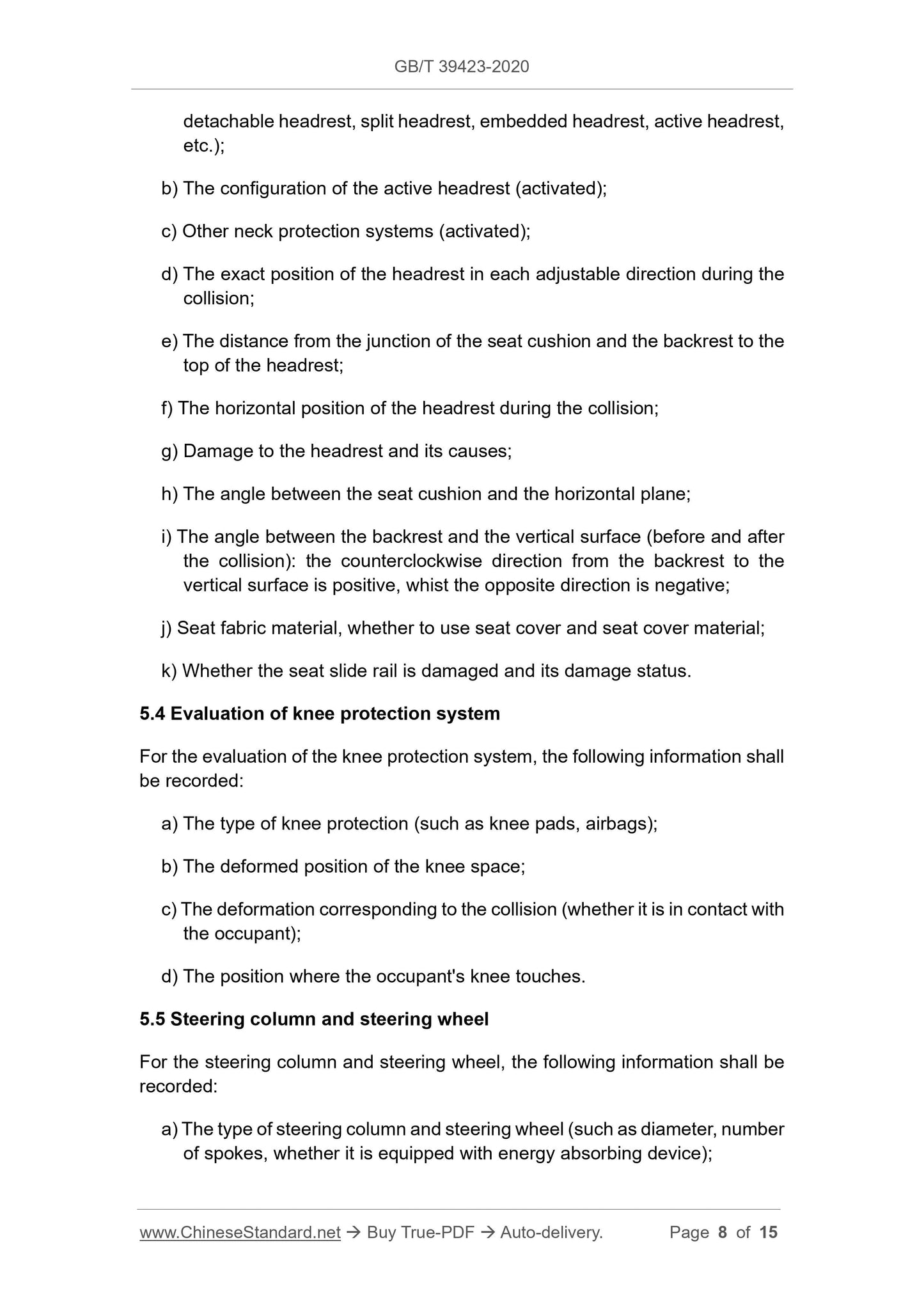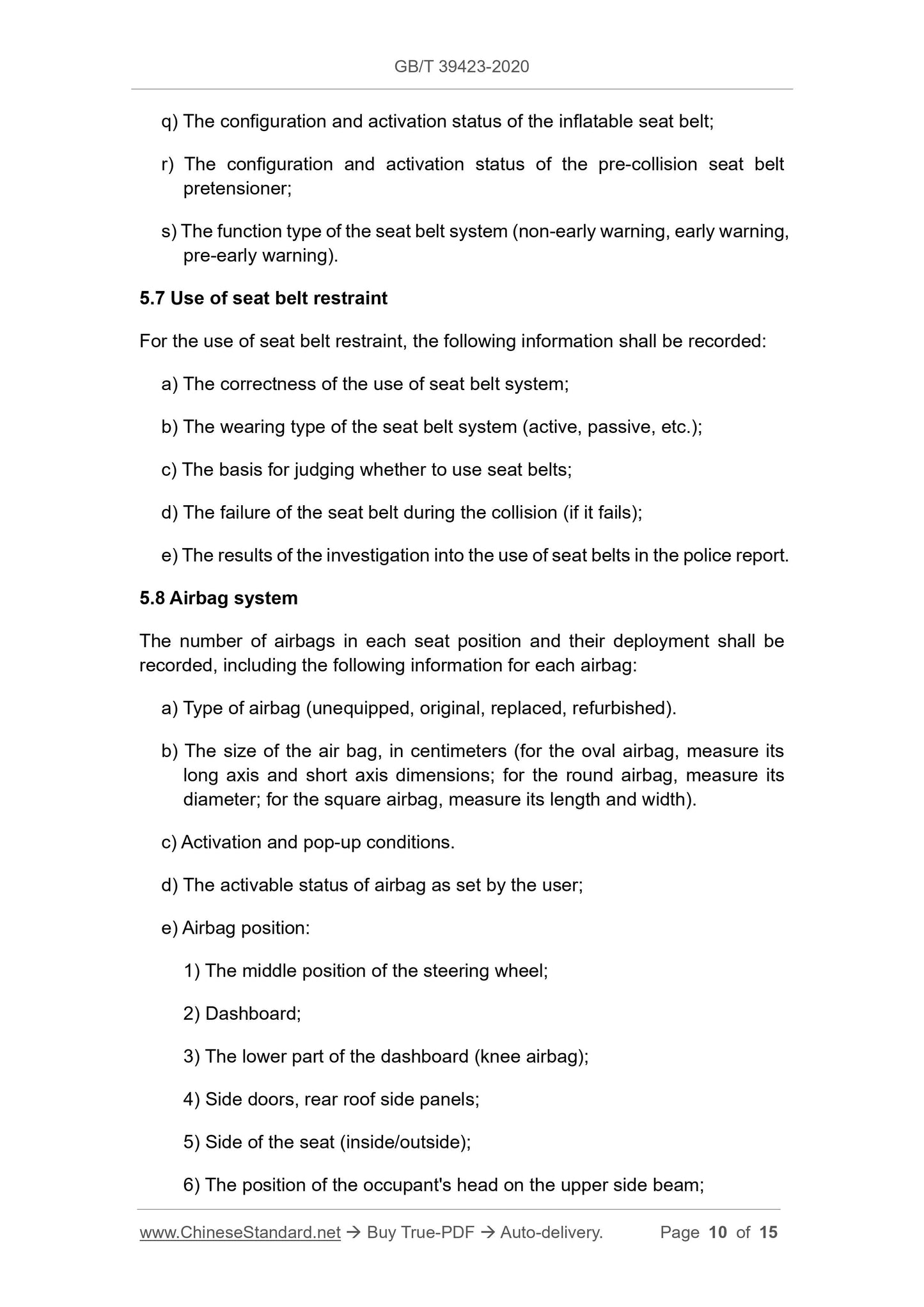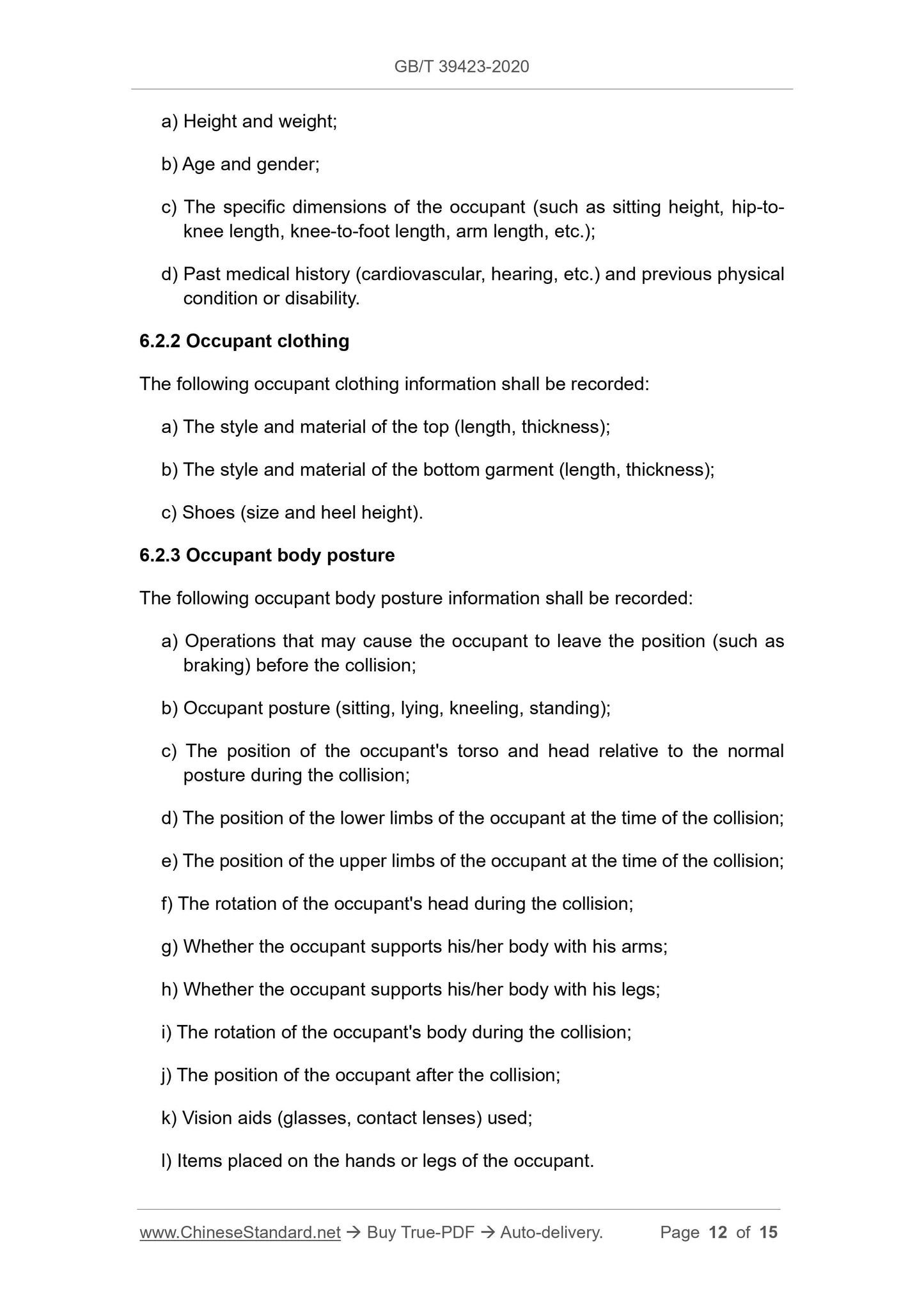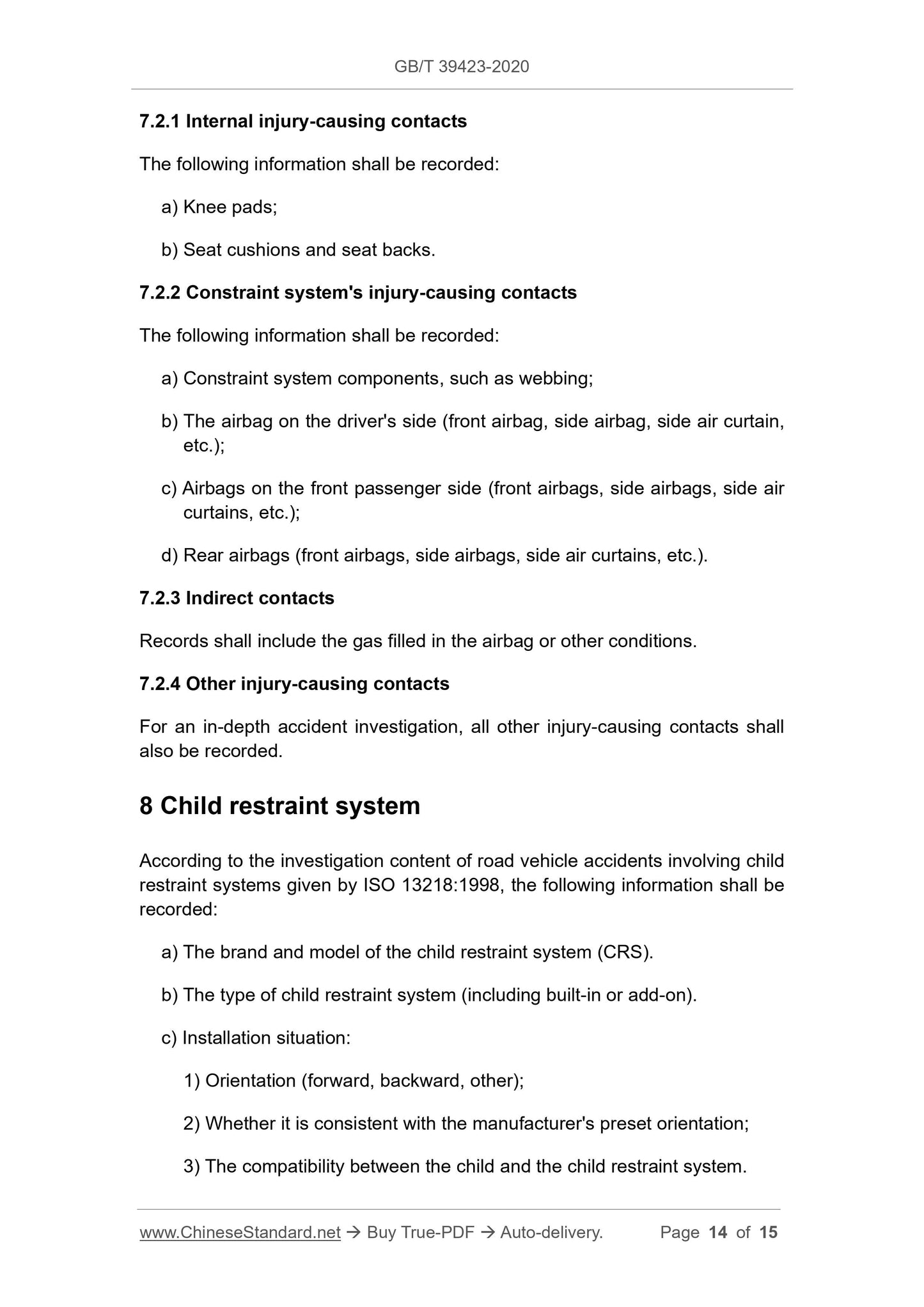1
/
of
7
PayPal, credit cards. Download editable-PDF & invoice in 1 second!
GB/T 39423-2020 English PDF (GBT39423-2020)
GB/T 39423-2020 English PDF (GBT39423-2020)
Regular price
$155.00 USD
Regular price
Sale price
$155.00 USD
Unit price
/
per
Shipping calculated at checkout.
Couldn't load pickup availability
Delivery: 3 seconds. Download true-PDF + Invoice.
Get QUOTATION in 1-minute: Click GB/T 39423-2020
Historical versions: GB/T 39423-2020
Preview True-PDF (Reload/Scroll if blank)
GB/T 39423-2020: Road vehicles. Collection of accident data for evaluation of occupant restraint performance
GB/T 39423-2020
GB
NATIONAL STANDARD OF THE
PEOPLE’S REPUBLIC OF CHINA
ICS 43.020
T 04
Road vehicles - Collection of accident data for
evaluation of occupant restraint performance
(ISO 6546:2018, MOD)
ISSUED ON: NOVEMBER 19, 2020
IMPLEMENTED ON: JUNE 01, 2021
Issued by: State Administration for Market Regulation;
Standardization Administration of PRC.
Table of Contents
Foreword ... 3
1 Scope ... 5
2 Normative references ... 5
3 Terms and definitions ... 5
4 Vehicle data ... 5
5 Seat and restraint data ... 7
6 Occupant data ... 11
7 Occupant injury data ... 13
8 Child restraint system ... 14
Road vehicles - Collection of accident data for
evaluation of occupant restraint performance
1 Scope
This standard specifies the collection of vehicle data, seat and restraint data,
occupant data, occupant injury data, child restraint system data for evaluating
occupant restraint performance.
This standard applies to accident data collection for evaluating the performance
of passenger restraint systems for passenger cars and trucks.
This standard does not apply to the evaluation of deformation, intrusion,
structural design related to the structural performance of the whole vehicle.
2 Normative references
The following documents are essential to the application of this document. For
the dated documents, only the versions with the dates indicated are applicable
to this document; for the undated documents, only the latest version (including
all the amendments) is applicable to this standard.
GB/T 39424.1-2020 Road vehicle - Traffic accident analysis - Part 1:
Terminology (ISO 12353-1:2020, MOD)
ISO 13218:1998 Road vehicles - Child restraint systems -Report form for
accidents involving child passengers
3 Terms and definitions
The terms and definitions defined in GB/T 39424.1-2020 are applicable to this
document.
4 Vehicle data
Vehicle data includes accident data such as vehicle identification information,
vehicle state before collision, collision mode, vehicle damage/intrusion, collision
object, collision severity parameters, as well as but not limited to occupant
restraint related data:
detachable headrest, split headrest, embedded headrest, active headrest,
etc.);
b) The configuration of the active headrest (activated);
c) Other neck protection systems (activated);
d) The exact position of the headrest in each adjustable direction during the
collision;
e) The distance from the junction of the seat cushion and the backrest to the
top of the headrest;
f) The horizontal position of the headrest during the collision;
g) Damage to the headrest and its causes;
h) The angle between the seat cushion and the horizontal plane;
i) The angle between the backrest and the vertical surface (before and after
the collision): the counterclockwise direction from the backrest to the
vertical surface is positive, whist the opposite direction is negative;
j) Seat fabric material, whether to use seat cover and seat cover material;
k) Whether the seat slide rail is damaged and its damage status.
5.4 Evaluation of knee protection system
For the evaluation of the knee protection system, the following information shall
be recorded:
a) The type of knee protection (such as knee pads, airbags);
b) The deformed position of the knee space;
c) The deformation corresponding to the collision (whether it is in contact with
the occupant);
d) The position where the occupant's knee touches.
5.5 Steering column and steering wheel
For the steering column and steering wheel, the following information shall be
recorded:
a) The type of steering column and steering wheel (such as diameter, number
of spokes, whether it is equipped with energy absorbing device);
q) The configuration and activation status of the inflatable seat belt;
r) The configuration and activation status of the pre-collision seat belt
pretensioner;
s) The function type of the seat belt system (non-early warning, early warning,
pre-early warning).
5.7 Use of seat belt restraint
For the use of seat belt restraint, the following information shall be recorded:
a) The correctness of the use of seat belt system;
b) The wearing type of the seat belt system (active, passive, etc.);
c) The basis for judging whether to use seat belts;
d) The failure of the seat belt during the collision (if it fails);
e) The results of the investigation into the use of seat belts in the police report.
5.8 Airbag system
The number of airbags in each seat position and their deployment shall be
recorded, including the following information for each airbag:
a) Type of airbag (unequipped, original, replaced, refurbished).
b) The size of the air bag, in centimeters (for the oval airbag, measure its
long axis and short axis dimensions; for the round airbag, measure its
diameter; for the square airbag, measure its length and width).
c) Activation and pop-up conditions.
d) The activable status of airbag as set by the user;
e) Airbag position:
1) The middle position of the steering wheel;
2) Dashboard;
3) The lower part of the dashboard (knee airbag);
4) Side doors, rear roof side panels;
5) Side of the seat (inside/outside);
6) The position of the occupant's head on the upper side beam;
a) Height and weight;
b) Age and gender;
c) The specific dimensions of the occupant (such as sitting height, hip-to-
knee length, knee-to-foot length, arm length, etc.);
d) Past medical history (cardiovascular, hearing, etc.) and previous physical
condition or disability.
6.2.2 Occupant clothing
The following occupant clothing information shall be recorded:
a) The style and material of the top (length, thickness);
b) The style and material of the bottom garment (length, thickness);
c) Shoes (size and heel height).
6.2.3 Occupant body posture
The following occupant body posture information shall be recorded:
a) Operations that may cause the occupant to leave the position (such as
braking) before the collision;
b) Occupant posture (sitting, lying, kneeling, standing);
c) The position of the occupant's torso and head relative to the normal
posture during the collision;
d) The position of the lower limbs of the occupant at the time of the collision;
e) The position of the upper limbs of the occupant at the time of the collision;
f) The rotation of the occupant's head during the collision;
g) Whether the occupant supports his/her body with his arms;
h) Whether the occupant supports his/her body with his legs;
i) The rotation of the occupant's body during the collision;
j) The position of the occupant after the collision;
k) Vision aids (glasses, contact lenses) used;
l) Items placed on the hands or legs of the occupant.
7.2.1 Internal injury-causing contacts
The following information shall be recorded:
a) Knee pads;
b) Seat cushions and seat backs.
7.2.2 Constraint system's injury-causing contacts
The following information shall be recorded:
a) Constraint system components, such as webbing;
b) The airbag on the driver's side (front airbag, side airbag, side air curtain,
etc.);
c) Airbags on the front passenger side (front airbags, side airbags, side air
curtains, etc.);
d) Rear airbags (front airbags, side airbags, side air curtains, etc.).
7.2.3 Indirect contacts
Records shall include the gas filled in the airbag or other conditions.
7.2.4 Other injury-causing c...
Get QUOTATION in 1-minute: Click GB/T 39423-2020
Historical versions: GB/T 39423-2020
Preview True-PDF (Reload/Scroll if blank)
GB/T 39423-2020: Road vehicles. Collection of accident data for evaluation of occupant restraint performance
GB/T 39423-2020
GB
NATIONAL STANDARD OF THE
PEOPLE’S REPUBLIC OF CHINA
ICS 43.020
T 04
Road vehicles - Collection of accident data for
evaluation of occupant restraint performance
(ISO 6546:2018, MOD)
ISSUED ON: NOVEMBER 19, 2020
IMPLEMENTED ON: JUNE 01, 2021
Issued by: State Administration for Market Regulation;
Standardization Administration of PRC.
Table of Contents
Foreword ... 3
1 Scope ... 5
2 Normative references ... 5
3 Terms and definitions ... 5
4 Vehicle data ... 5
5 Seat and restraint data ... 7
6 Occupant data ... 11
7 Occupant injury data ... 13
8 Child restraint system ... 14
Road vehicles - Collection of accident data for
evaluation of occupant restraint performance
1 Scope
This standard specifies the collection of vehicle data, seat and restraint data,
occupant data, occupant injury data, child restraint system data for evaluating
occupant restraint performance.
This standard applies to accident data collection for evaluating the performance
of passenger restraint systems for passenger cars and trucks.
This standard does not apply to the evaluation of deformation, intrusion,
structural design related to the structural performance of the whole vehicle.
2 Normative references
The following documents are essential to the application of this document. For
the dated documents, only the versions with the dates indicated are applicable
to this document; for the undated documents, only the latest version (including
all the amendments) is applicable to this standard.
GB/T 39424.1-2020 Road vehicle - Traffic accident analysis - Part 1:
Terminology (ISO 12353-1:2020, MOD)
ISO 13218:1998 Road vehicles - Child restraint systems -Report form for
accidents involving child passengers
3 Terms and definitions
The terms and definitions defined in GB/T 39424.1-2020 are applicable to this
document.
4 Vehicle data
Vehicle data includes accident data such as vehicle identification information,
vehicle state before collision, collision mode, vehicle damage/intrusion, collision
object, collision severity parameters, as well as but not limited to occupant
restraint related data:
detachable headrest, split headrest, embedded headrest, active headrest,
etc.);
b) The configuration of the active headrest (activated);
c) Other neck protection systems (activated);
d) The exact position of the headrest in each adjustable direction during the
collision;
e) The distance from the junction of the seat cushion and the backrest to the
top of the headrest;
f) The horizontal position of the headrest during the collision;
g) Damage to the headrest and its causes;
h) The angle between the seat cushion and the horizontal plane;
i) The angle between the backrest and the vertical surface (before and after
the collision): the counterclockwise direction from the backrest to the
vertical surface is positive, whist the opposite direction is negative;
j) Seat fabric material, whether to use seat cover and seat cover material;
k) Whether the seat slide rail is damaged and its damage status.
5.4 Evaluation of knee protection system
For the evaluation of the knee protection system, the following information shall
be recorded:
a) The type of knee protection (such as knee pads, airbags);
b) The deformed position of the knee space;
c) The deformation corresponding to the collision (whether it is in contact with
the occupant);
d) The position where the occupant's knee touches.
5.5 Steering column and steering wheel
For the steering column and steering wheel, the following information shall be
recorded:
a) The type of steering column and steering wheel (such as diameter, number
of spokes, whether it is equipped with energy absorbing device);
q) The configuration and activation status of the inflatable seat belt;
r) The configuration and activation status of the pre-collision seat belt
pretensioner;
s) The function type of the seat belt system (non-early warning, early warning,
pre-early warning).
5.7 Use of seat belt restraint
For the use of seat belt restraint, the following information shall be recorded:
a) The correctness of the use of seat belt system;
b) The wearing type of the seat belt system (active, passive, etc.);
c) The basis for judging whether to use seat belts;
d) The failure of the seat belt during the collision (if it fails);
e) The results of the investigation into the use of seat belts in the police report.
5.8 Airbag system
The number of airbags in each seat position and their deployment shall be
recorded, including the following information for each airbag:
a) Type of airbag (unequipped, original, replaced, refurbished).
b) The size of the air bag, in centimeters (for the oval airbag, measure its
long axis and short axis dimensions; for the round airbag, measure its
diameter; for the square airbag, measure its length and width).
c) Activation and pop-up conditions.
d) The activable status of airbag as set by the user;
e) Airbag position:
1) The middle position of the steering wheel;
2) Dashboard;
3) The lower part of the dashboard (knee airbag);
4) Side doors, rear roof side panels;
5) Side of the seat (inside/outside);
6) The position of the occupant's head on the upper side beam;
a) Height and weight;
b) Age and gender;
c) The specific dimensions of the occupant (such as sitting height, hip-to-
knee length, knee-to-foot length, arm length, etc.);
d) Past medical history (cardiovascular, hearing, etc.) and previous physical
condition or disability.
6.2.2 Occupant clothing
The following occupant clothing information shall be recorded:
a) The style and material of the top (length, thickness);
b) The style and material of the bottom garment (length, thickness);
c) Shoes (size and heel height).
6.2.3 Occupant body posture
The following occupant body posture information shall be recorded:
a) Operations that may cause the occupant to leave the position (such as
braking) before the collision;
b) Occupant posture (sitting, lying, kneeling, standing);
c) The position of the occupant's torso and head relative to the normal
posture during the collision;
d) The position of the lower limbs of the occupant at the time of the collision;
e) The position of the upper limbs of the occupant at the time of the collision;
f) The rotation of the occupant's head during the collision;
g) Whether the occupant supports his/her body with his arms;
h) Whether the occupant supports his/her body with his legs;
i) The rotation of the occupant's body during the collision;
j) The position of the occupant after the collision;
k) Vision aids (glasses, contact lenses) used;
l) Items placed on the hands or legs of the occupant.
7.2.1 Internal injury-causing contacts
The following information shall be recorded:
a) Knee pads;
b) Seat cushions and seat backs.
7.2.2 Constraint system's injury-causing contacts
The following information shall be recorded:
a) Constraint system components, such as webbing;
b) The airbag on the driver's side (front airbag, side airbag, side air curtain,
etc.);
c) Airbags on the front passenger side (front airbags, side airbags, side air
curtains, etc.);
d) Rear airbags (front airbags, side airbags, side air curtains, etc.).
7.2.3 Indirect contacts
Records shall include the gas filled in the airbag or other conditions.
7.2.4 Other injury-causing c...
Share
